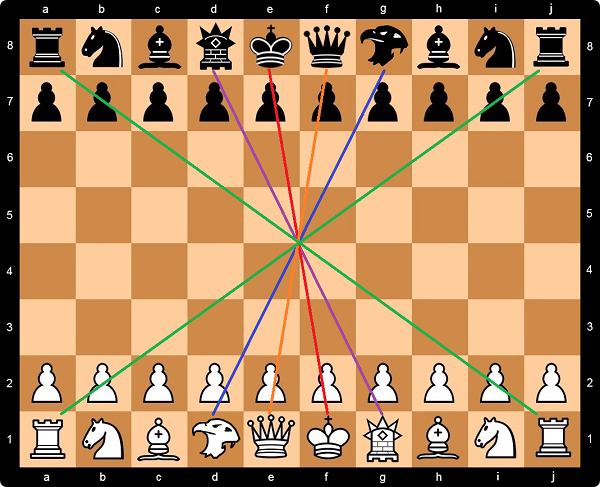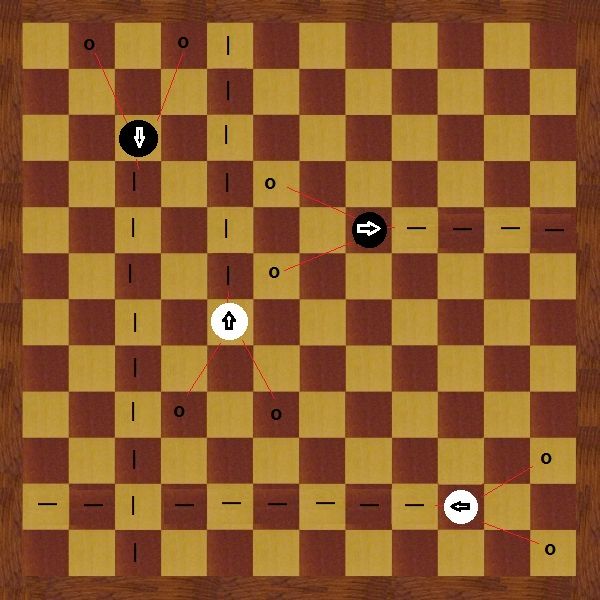
Weakest and Strongest Pieces







I'm glad you are feeling better from the flue. I hope you have recovered completely.




OK, this should be a good game.![]()
All the pawns are corporals, right? I changed the appearance of them just a little to remind us it's a new type of piece. I hope it's OK with you.

Griffin (Gryphon) is going to be a hell of a piece to try. I think it's going to be challenging to use this piece and see how much wrath it's going to blow.
...this is going to be Griffin Chess.
Hi brainking2016. I started a thread for our game (here).![]()

Is there any chance you would like to try two gryphons on the "Infinite Plane" chessboard?

Inventing more weak pieces is interesting. See also this topic:
https://www.chess.com/forum/view/chess960-chess-variants/team-mate-chess
I was thinking about the compound of the Shogi Lance and the reversed Shogi Keima:

Initially it moves rook-wise but only forward, or backwards like a reversed Shogi Knight as shown in te picture.
But it depends on orientation, so we could allow that the orientation can be rotated by 90 degrees, but this would take one turn and the arrow would remain on the same square.
Obviously much weaker than the Superchess Empress, which has Rook- and Knight moves in all directions.

Complete information dice:
Initially, the one dot face is on top.
The dice moves orthogonally exactly as many squares as the number of dots on top. The dice can be turned at will (not rolled - this is why I'm calling it a complete information dice) but this takes one turn, and then the dice remains on its square.
Very weak. I don't know how to mate KBN vs K, but taking an extra complete information dice won't help me either.

My tablebase generator confirms that KBAK (A=Arrow) is generally won. Even without rotating the Arrow. (Which is just as well, as it cannot handle identity-changing pieces.) Even in combination with Wazir or Ferz the Arrow can force checkmate on a bare King (except that there is always a significant percentage of initial positions with F or W where these can be chased by the bare King towards their doom, and the Arrow cannot quickly protect them from a distance). Knight + Arrow is also generally won.
Complete-info dice (singular: Die, btw) are indeed excessively weak, because the options they can choose from are already all very weak 4-leapers. Yet it should be helpful in KBNK, as you could keep it permanently on 1 to make it a Wazir, and both KBWK and KNWK are generally won (again, when the Wazir is not cut off from its friends, which isn't so much of a problem with a Bishop). The crux is that the Wazir cannot only switch its attack from c1 to b1 in a single move (i.e. reach b1 from c1 in 3 moves: an uncapture, move and capture), but while attacking b1 can attack c2 at the same time. (So that you can afford to have the King on a3 rather than b3, making room for the Knight to cover a1 & c1; with Knights this is generally a problem not met with other forking pieces such as Camel.)
The Bishop can switch its attack from c1 to a1 in one move, which is sufficient in combination with almost any piece. (Except of course color-bound pieces on the same shade.) In fact there is a conjecture that a Bishop is able to force mate in combination with a weak leaper on boards of any size, as together with a King it can confine the bare King dynamically to a corner, with one move to spare each time the bare King has to change direction because it hits the edge.